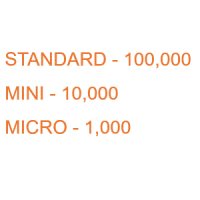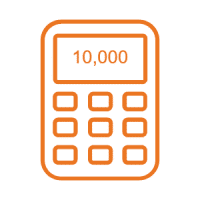Table of content
The Forex lot definition refers to the amount of money you use when trading currencies. It represents the size of your position and can affect how profitable your sessions are in the market. Some brokers use lots to show the size of a position, while others use currency units as the indicators.
The most popular lot size is the standard one, which consists of 100,000 currency units. Put simply, a trader will have a standard size lot if their position size is 100,000 currency units of their chosen base currency. With that in hand, a trader can go on to trade any currency pair that has its funding currency in it.
Other Forex lot cost sizes include mini, micro, and nano, which each consist of 10,000, 1,000, and 100 currency units respectively. Moreover, the lot itself can be standard, partial, or round turn – and we will discuss the difference between the lot size and the lot type later in this review.
In this guide, we will have a closer look at various lot sizes, as well as the perks of using one lot size over the other. We will also explain what a trading volume is and how you can calculate it.
Lot sizes vs lot types – What’s the difference?
 It is common knowledge that Forex trading is a potentially risky financial enterprise. A trader needs to understand what various trading sizes and trading types encompass in order to facilitate their profits and manage their trading funds accordingly.
It is common knowledge that Forex trading is a potentially risky financial enterprise. A trader needs to understand what various trading sizes and trading types encompass in order to facilitate their profits and manage their trading funds accordingly.
Luckily, the ability to choose your preferred lot size and type can have a significant effect on your effectiveness in the market- but what is the difference between the two? Unlike Forex trading lot definition, lot types depend on both the lot size used and the position that the trader opens.
The three main lot types are:
- Partial lot – can be observed when a trade is opened with a buy order for a standard size lot, but closed with a sell order that is only half of the buy order. The buy position is then not closed completely, and some portion of it is still pending.
- Lot – an ordinary trade that is opened and closed with a lot of any size.
- Round turn lot – occurs when a trader opens the buy trade and then closes it with a sell trade.
There is no clear answer as to which lot type shows the best results, as it depends on the trading strategies of individual traders. Moreover, the features of each of the lot types will depend heavily on which Forex account lot size you will end up choosing. But why and how do lot sizes matter?
Forex lot size chart explained: How to choose “the one”?
A Forex lot refers to how sensitive your trading funds will be to the major market developments. For example, a 50-pip move will barely be noticeable on a small trade, but it could be quite visible in a large-scale trade.
Below, you will find a breakdown of the various lot size values and some suggestions on when best to use them.
Micro lot account: is the smallest account that you can get. The cost of this one would be 1,000 USD ( if your account is funded in US dollars), or an equivalent. Consequently, the cost of one pip for this account would be 10 cents.
Forex micro lot account is really good for those who are only just starting with Forex trading and prefer some skill-building over the unnecessary risks.
Mini lot account: the value of this account will stand at 10,000 currency units of your funding currency. To give you some perspective, this means that if your account is funded by the USD, the cost of one pip will be 1 USD.
Although this might not seem like a huge difference from the micro, you should remember that the market can move by 100 pips a day. By choosing the Forex mini lot, you should bear in mind that you could potentially be looking at the losses as high as 100 USD or equivalent.

Forex standard lot is the most popular lot size that you can get. This is a 100,000 unit account, which equals 100,000 USD if that is your base currency.
Overall, it is advised to the beginners to start with the smaller-sized lots, as in that case, their trading funds will be less vulnerable to market volatility, and once the skill and knowledge will suffice, a trader can move on to the larger, standard account.
If the trader wishes to increase their lot sizes, they can use the Forex lot leverage, although it could increase the chances of the potential losses exceeding the funds that were originally deposited.
How to calculate the lot size easily?
What we have provided above is a general overview of the different sizes of Forex lots, which will mostly be useful to beginners. However, more experienced traders will benefit from the Forex lot size formula, which will help determine the lot size to use with various currency pairs. It goes as follows:
((Percentage x Margin) ÷ Pip Amount) ÷ 100k = Lot Size
Although this formula seems quite straight-forward and easy to comprehend, you do not have to calculate your lot size manually every time. There is a variety of Forex lot size calculators that can complete this task within seconds, hassle-free. All you will need to do is fill in the necessary fields with the appropriate numbers (such as the Forex lot value, and the exchange rate that of the currency pairs you wish to trade) and receive the result of the calculation.
What is a trading volume and why does it matter?
 Volume in trading refers to the total amount of your trades included in the trading position. The volume is usually used by the brokers to determine the size of their traders. However, the latter might also find it useful to calculate it to determine whether they will have access to the perks that the brokerage has to provide.
Volume in trading refers to the total amount of your trades included in the trading position. The volume is usually used by the brokers to determine the size of their traders. However, the latter might also find it useful to calculate it to determine whether they will have access to the perks that the brokerage has to provide.
The main formula to calculate the volume is the exchange rate multiplied by the Forex account lot size. Nevertheless, the formula differs depending on the lot type that you end up choosing. Here is how to calculate each one of them:
- With a partial lot, the first buy position will give the trader 1 lot first. When only half of that lot is closed with the sell position, 0.5 is gained. When those two are combined, the trader will end up with 1.5 lots of the trading volume.
- The round turn lot will also give traders 1 lot for the buying position, and 1 more lot for the selling position, as it is exchanged for the same currency. Overall, the trader will gain 2 lots in the trading volume.
- The regular lot will give its trader 1 lot of the trading volume for the buying position, and no more lots will be added until the trade is closed.
How best to approach the Forex lot size?
Successful traders usually recommend choosing the lot size that best suits your trading needs and avoiding unnecessary risks where possible. As the Forex lot size varies, your best way to approach it would be to never risk more than 2% of your trading funds at once.
Moreover, experienced traders also tend to pay special attention to the pip values relative to the lot size for a certain currency that you are trading at a certain time. Luckily, with the Forex brokers lot size, you will be able to get this information directly from your brokerage and use it to figure out your potential profits and losses.
Key takeaways on Forex lots
The lot in Forex trading, in a nutshell, is the unit of measurement, mostly used by brokers to determine the size of their traders based on their trading volumes. The size of the lot on the Forex lot size table can vary between 100 – 100, 000 currency units.
The volume of trading refers to the sum total of all the trades that the trader has carried out. The higher it is, the more access they will have to some advanced tools and services. On top of that, one can find 3 types of lots to choose from: partial, regular, and round turn.
Frequently Asked Questions on Forex lot quality
Where is my trading volume tracked?
How can I increase my trading volume?
Why use lots and not just regular numbers?



